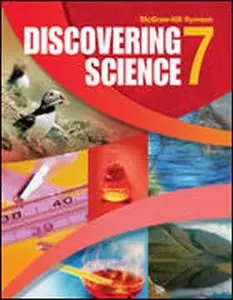Discovering Science 7
Publisher: McGraw-Hill Ryerson | 2008 | ISBN: 0070726027 | PDF | 64.1 MB
Publisher: McGraw-Hill Ryerson | 2008 | ISBN: 0070726027 | PDF | 64.1 MB
This exciting resource developed specifically for the new curriculum provides solid science process skills reinforcement,engaging text and visuals, and a wide choice of easy-to-do hands-on activities to meet the needs of every learner.
Features:
- Labs and activities featuring inexpensive, easy-to-obtain materials are suited to both elementary and middle school classrooms.
- Feature photographs, locations, examples, role models, and careers.
- Reading Check features enhance students? reading comprehension.
- Ask an Elder profiles integrate Aboriginal perspectives with science content.
Table of Contents :
Discovering Science 7
- A Tour of Your Textbook
- Safety in Your Science Classroom
Unit 1 Interactions within Ecosystems
- Getting Started
- Find Out Activity: What is an Ecosystem
Chapter 1 An ecosystem is all the living and non-living things in a particular place.
- Types of Ecosystems
- Abiotic Parts of an Ecosystem
- Biotic Parts of an Ecosystem
- Chapter 1 Review
Chapter 2 Living and non-living things interact in ecosystems.
- Types of Interactions
- Roles of Organisms
- Food Chains, Food Webs, and the Transfer of Energy
- Cycles of Matter in Ecosystems
- Chapter 2 Review
Chapter 3 Natural events and human activities cause changes in ecosystems
- Natural Disturbances and Succession
- The Impact of People on Ecosystems
- Monitoring and Managing Ecosystems
- Chapter 3 Review
- Unit 1 Summary
- Unit 1 Project: Making a Garbage-Reduction Diary
- Unit 1 Integrated Research Project: Saving Endangered Spaces
- Unit 1 Review
Unit 2 Heat
- Getting Started
- Find Out Activity: Baffle Your Skin
Chapter 4 Temperature describes how hot or cold an object is.
- Describing Temperature
- Measuring Temperature
- Chapter 4 Review
Chapter 5 Scientists use the particle theory of matter to describe temperature.
- Particle Theory of Matter
- States of Matter
- Changes of State
- Chapter 5 Review
Chapter 6 Heat is transferred from one place to another by three different processes.
- Processes of Transferring Heat
- Conductors and Insulators
- Temperature versus Heat
- Chapter 6 Review
- Unit 2 Summary
- Unit 2 Project: Water Heater
- Unit 2 Integrated Research Investigation: Building Codes and Insulation
- Unit 2 Review
Unit 3 Mixtures and Solutions
- Getting Started
- Find Out Activity: Mixed or Pure?
Chapter 7 Matter can be classified as mixtures or pure substances.
- How Mixtures Are Different from Pure Substances
- Classifying Mixtures
- Chapter 7 Review
Chapter 8 Some substances dissolve to form solutions faster and more easily than others.
- Making Solutions: Solutes and Solvents
- Concentration and Solubility
- Chapter 8 Review
Chapter 9 Many useful products depend on technology for separating mixtures and solutions
- Separating Mixtures and Solutions
- Separating Mixtures from Underground
- Chapter 9 Review
- Unit 3 Summary
- Unit 3 Project: Purifying Mixtures
- Unit 3 Integrated Research Investigation: Safe, Clean Water for Everyone
- Unit 3 Review
Unit 4 Earth's Crust
- Getting Started
- Find Out Activity: What Makes a Rock a Rock?
Chapter 10 Earth's crust is made up of rocks and minerals.
- Investigating Minerals
- Investigating Rocks
- The Rock Cycle and Rock and Mineral Resources
- Chapter 10 Chapter Review
Chapter 11 Earth's crust is constantly changing.
- A Moving, Changing Crust
- How Earthquakes and Volcanoes Shape Earth's Crust
- Mountain Building and Geologic Time
- Chapter 11 Chapter Review
Chapter 12 Soil is the living component of Earth's crust.
- Weathering, Erosion, and Soil Formation
- Soil Types and Characteristics
- Sustaining Fertile Soils
- Chapter 12 Chapter Review
- Unit 4 Summary
- Unit 4 Project: Modelling Geological Processes in Your Community
- Unit 4 Integrated Research Investigation: Soil Super Stars
- Unit 4 Review
Science Skills
ScienceSkill 1 Organizing and Communicating Scientific Data
ScienceSkill 2 Designing and Conducting Experiments
ScienceSkill 3 Metric Conversion and SI Units
ScienceSkill 4 Measurement
ScienceSkill 5 Qualitative and Quantitative Observations
ScienceSkill 6 Communicating Your Lab Work in a Lab Report
ScienceSkill 7 Common Laboratory Equipment
ScienceSkill 8 Using a Microscope
ScienceSkill 9 Using Graphic Organizers
Glossary
Index
Credits



